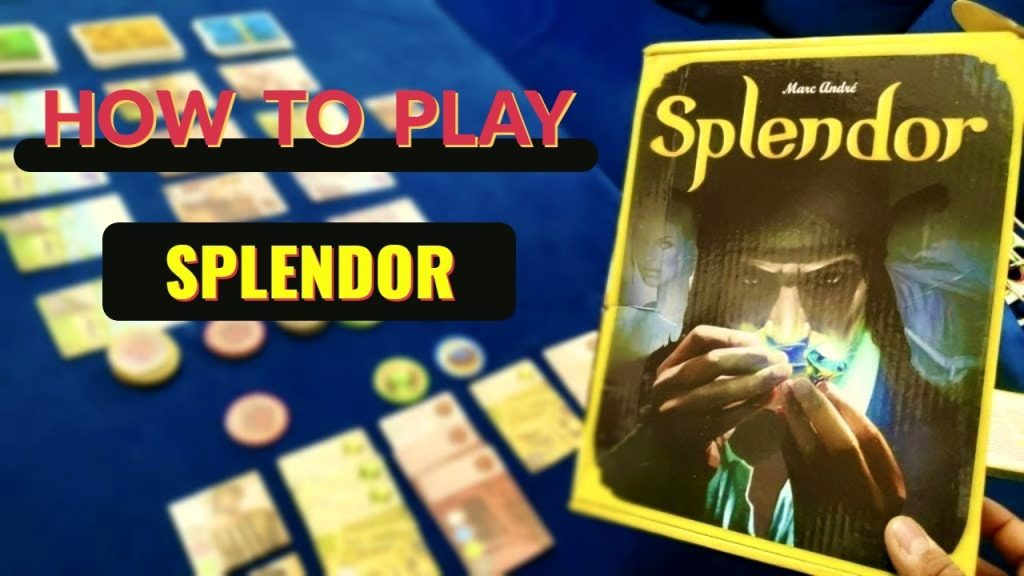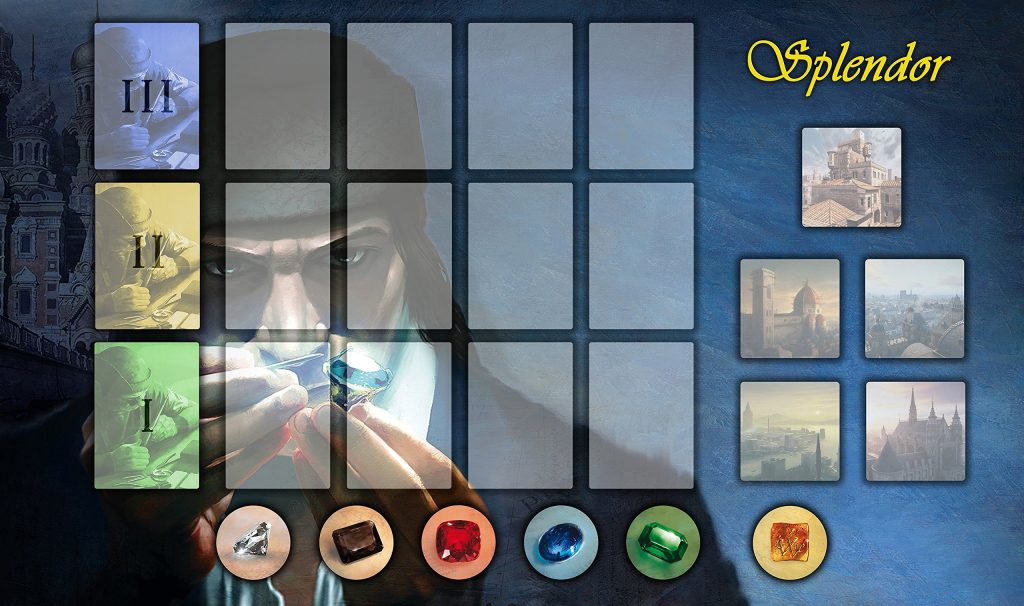Introduction
Splendor board game is one of the most beloved and accessible modern board games, combining elegant design, strategic depth, and quick gameplay. Published by Space Cowboys and designed by Marc André, Splendor board game has captivated players worldwide with its blend of resource management, engine-building, and tactical planning. Suitable for 2 to 4 players and with a playtime of around 30 minutes, Splendor is easy to learn but offers a surprising amount of strategic choice.
The game’s theme revolves around Renaissance merchants acquiring gem mines, transportation methods, and shops to gain prestige points and attract the favor of nobles. While the rules are relatively simple, understanding how to play Splendor board game well requires a solid grasp of its core mechanics, turn structure, and long-term strategy. In this comprehensive guide, we’ll walk you through every aspect of how to play the Splendor board game—from setup and gameplay flow to winning strategies and common mistakes.
Setting Up The Game: Understanding The Components And Layout

Before diving into gameplay, it’s essential to understand how to set up a game of Splendor. The game includes three decks of development cards (Level 1, Level 2, and Level 3), 40 poker-style gem tokens in five colors (emerald, sapphire, ruby, diamond, and onyx), five gold “joker” tokens, and a number of noble tiles based on the number of players. To begin, you’ll shuffle each deck separately and lay out four face-up cards from each level.
The gem tokens are placed in stacks sorted by color in the center of the table, forming a supply. Noble tiles are also placed face-up above the cards. These nobles are not claimed through purchase but are instead earned automatically when a player meets the specific requirements on their turn. The goal is to accumulate prestige points by purchasing development cards and attracting nobles through smart resource management and strategic planning.
The Objective: Prestige Points And Strategic Acquisition
The ultimate objective in Splendor is to be the first player to reach 15 prestige points. Prestige points are primarily earned through the purchase of development cards, many of which are worth points depending on their tier. Level 1 cards typically do not offer points, while Level 2 and Level 3 cards can provide more significant rewards.
Nobles also offer points—usually three—and can be a decisive factor in a close game. Players must balance building a long-term engine that allows efficient card acquisition with the need to accumulate prestige points faster than their opponents. The challenge lies in managing limited resources and recognizing when to shift from building your engine to grabbing points in the late game.
Understanding The Turn Structure: Four Key Options
Each player’s turn in Splendor board game involves choosing one of four actions. The most common action is taking gem tokens from the central supply. A player may take either three different colored tokens or two tokens of the same color (if there are at least four of that color remaining in the supply). The second action is reserving a development card. This allows a player to take one card—face-up or blindly from the deck—and hold it in their hand for future purchase while also taking a gold token, which acts as a wild gem. Reserving is a powerful tactic to block opponents or secure expensive cards for later.
The third action is purchasing a development card, either from the central layout or from your reserved cards. To buy a card, you pay the required number of gem tokens shown on the card. Once purchased, the card becomes part of your tableau, granting a permanent discount in that card’s color for all future purchases. The fourth and final action is claiming a noble tile, which occurs automatically if you meet its requirements—usually a specific number of cards in certain colors. Understanding when to take each of these actions is key to building a successful strategy and outpacing your opponents.
Building Your Engine: The Heart Of Splendor Strategy

At its core, Splendor board game is an engine-building game. This means players aim to create a self-sustaining cycle that grows more efficient over time. In Splendor, this engine consists of the development cards you’ve purchased, each of which provides a permanent gem bonus in a specific color. These bonuses reduce the number of tokens needed to buy future cards, essentially acting as a discount.
For example, if you’ve already purchased three blue cards, any future card that requires blue gems is reduced by three in cost. The key to success is building a balanced engine that includes cards in various colors, allowing flexibility in purchasing higher-level cards and meeting noble requirements. Early in the game, players typically focus on acquiring Level 1 cards to build their engine quickly and efficiently. As their discount power grows, they transition to buying Level 2 and Level 3 cards to earn prestige points and finish the game.
Strategic Card Selection: Planning Ahead For Prestige
Splendor board game, Not all development cards are created equal, and strategic selection is vital in Splendor. While it’s tempting to simply grab the cheapest available card, successful players often think several turns ahead. They prioritize cards that complement their existing engine and bring them closer to meeting the requirements for nobles.
Cards that cost fewer tokens but provide a valuable gem bonus are often better long-term investments than high-cost, high-point cards that stall your momentum. Splendor board game, keeping an eye on your opponents’ engines and card purchases is important. You may want to reserve a card not only because it fits your strategy but also because it prevents an opponent from claiming it. The balance between acquiring cards for strategic advantage and cards that earn points is delicate but crucial for winning.
Using Gold Tokens And Reservations Effectively
Gold tokens are perhaps the most flexible and tactical component of Splendor board game. Each gold token acts as a wild gem that can substitute for any color, allowing you to complete purchases that might otherwise be just out of reach. However, gold tokens are only gained by reserving cards, and each player is limited to holding a maximum of three reserved cards and ten total tokens. Timing your reservations well is a powerful tactic.
You can reserve a card that you want to buy later, but you can also use reservations to block your opponents. For example, if a high-point card is clearly within reach of another player, reserving it denies them that opportunity while giving you time to develop your own engine. Overusing reservations, however, can clog your hand with cards you may never use, so it’s best to reserve with purpose.
Nobles: Silent But Strategic Point Sources
Nobles in Splendor board game offer prestige points without requiring token payments, but they are often overlooked by newer players. Earning a noble happens automatically at the end of your turn if you have the required number of cards in the specified colors. Each noble demands a combination of three types of gem cards, usually three or four of each color.
Since nobles offer three prestige points each, claiming one or two during the game can significantly accelerate your path to victory. Planning to meet a noble’s requirements should be part of your long-term strategy. As your engine grows, you can often position yourself to qualify for a noble while also pursuing high-point development cards. Some players even focus their entire strategy around attracting nobles, buying only the cards that fit those specific color combinations.
Endgame Scenarios And Victory Conditions
The game ends at the end of the round in which any player reaches 15 prestige points. If multiple players exceed this threshold during the same round, the winner is the one with the highest total points. Because the game ends after the current round, turn order can affect final outcomes. A player who reaches 15 first doesn’t automatically win if another player later in the turn order surpasses their score.
Splendor board game, This introduces a layer of timing strategy. Experienced players will sometimes delay taking a high-point card to allow for one more engine-building turn, potentially enabling a bigger play that not only reaches 15 points but secures a noble as well. Being mindful of your position in the turn order and calculating potential point swings is key to managing the endgame effectively.
Common Mistakes And How To Avoid Them

New players often make a few common mistakes when learning how to play Splendor. One of the most frequent is hoarding tokens without a clear plan, which results in inefficient turns and missed opportunities. Token management is essential; you should always take tokens with a specific purchase or reservation in mind. Another mistake is focusing too much on high-point cards early in the game. Without a strong engine, these cards are expensive and slow to acquire.
Prioritizing low-cost cards that provide gem bonuses allows you to scale your engine and make more impactful purchases later. Ignoring nobles is another strategic misstep. Players who overlook the value of these tiles may find themselves trailing in points despite having a solid engine. Splendor board game, failing to adapt to opponents’ strategies can be costly. Observing their progress and adjusting your tactics—whether by blocking key cards or racing to a noble—adds a vital layer of interactivity to your gameplay.
Variants And Expansions: Extending The Splendor Experience
While the base game of Splendor board game is a masterpiece of simplicity and elegance, expansions and variants can enhance the experience for veteran players. The most notable expansion, Splendor: Cities of Splendor, introduces four modular expansions, each adding new mechanics or goals.
For example, the Cities module replaces nobles with city tiles that require a different combination of points and bonuses to claim, changing the win condition and encouraging new strategies. The Trading Posts module adds special powers players can activate as their engine grows. While expansions aren’t necessary to enjoy the game, they can breathe new life into it and add fresh challenges for experienced players looking to test their strategic flexibility.
Conclusion
Learning how to play Splendor board game is easy, but mastering it requires strategic thought, careful planning, and adaptability. With its elegant mechanics and competitive depth, Splendor board game offers a rewarding experience for casual players and serious board gamers alike. By understanding the rules, optimizing your engine, balancing card acquisition with point generation, and keeping an eye on your opponents, you can consistently improve your performance and enjoy more satisfying sessions. Whether you’re new to board games or a seasoned strategist, Splendor is a timeless title that delivers quick but meaningful gameplay. The more you play, the more you’ll appreciate the subtle decisions that shape each game’s outcome.
